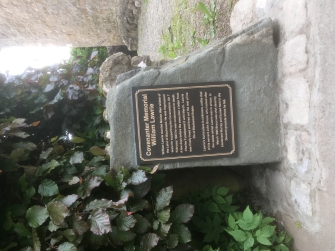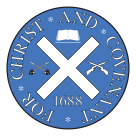
William Lawrie's Memorial
The Dovecot
Blackwood Estate
Lesmahagow
Lanarkshire
ML11 0JA
NGR - NS 774433
The memorial is located at The Dovecot within Blackwood Estate, Lanarkshire. The installation work was carried out meticulously by Terry Wise, owner of The Dovecot house, with some help from a neighbour with a JCB. The funding was secured from sources as follows: Blackwood and Kirkmuirhill Villages Co-ordination Group; B2BEvents, Newark, Nottinghamshire; and the SCMA.
WIlliam Lawrie of Blackwood
The Covenanters taking part in the Pentland Rising in 1666 marched by way of Lanark to Edinburgh. Shortly after leaving Lanark, they were met by William Lawrie of Blackwood, who rode up to the marching men. Lawrie came with a request from the Duke of Hamilton that the rising and the demands of the Covenanters should be agreed peacefully. Lawrie was the factor to the Earl of Douglas and resided at Blackwood House, near Kirkmuirhill, just over seven miles west of Lanark. His surname has been spelled Laurie and Lowrie in various accounts.
This William Lawrie belonged to Auchinheath and was married to Marion Weir, an heiress of George Weir of Blackwood. They had a son, Gavin Weir, and as William Lawrie brought him up, he was often referred to as the Tutor of Blackwood. Some accounts name him as William Weir, but he never apparently adopted this name, and he never had any claim to the estate in person.
Lawrie’s mission may have been self-inspired, for he carried no official document from the Duke. However, he claimed that the Duke has requested that he meet them ‘to see if possible effusion of blood might be shunned, and what we would be at’, according to Veitch/Bryson’s account. He continued, ‘This I heard he spoke of to some. He pretended to no written commission, but only verbal; neither did he apply himself to any amongst us who were at that time specially concerned to be spoken to’. Lawrie’s visit was confirmed by Turner: ‘Mr Laurie of Blackwood was brought to them; what his errand was I know not, bot if it was to intimate the proclamation and act of grace, he did it with so little noyse, and to so few, that not all their offeicers, much lesse their soldiers, knew any thing of it; neither did he so much as give me any hint of it, though he and I rode a full houre together’.
Many of the Covenanters had thought that Lawrie was intending joining their cause. However, when Wallace discovered that he was not intending becoming one of them, and that he was simply an emissary from the Duke of Hamilton, Wallace apparently ‘withdrew without a good night’ to him.
Not supporting them, many Covenanters felt that Lawrie should be taken prisoner, lest he return to Hamilton and Dalziel with information that would be of use to them.
It may have been at the end of this trip that Lawrie tried to negotiate with the leaders once more. He spoke with them again in the evening, but it was noted that he had nothing to add to what he had said earlier, apart from a warning from Dalziel as to the dangerous consequences they would find themselves in should they not accept his terms.
Yet again his pleas fell on deaf ears.
William Lawrie again appeared, having met with Dalziel in the meantime. He does not appear to have pled with the Covenanters this time, but instead was able to inform them that Dalziel and his men were at Calder, and thus the panic to move on dissipated, and the Covenanters were able to rest awhile at Newbridge.
Soon after the Covenanters agreed to march for Edinburgh, Lawrie appeared once more and asked to speak with Wallace and the leaders. According to Wallace, ‘All that he had to say was, in short, to see if he could persuade us to lay down arms upon an act of indemnity, which the Duke [of Hamilton] (said he) would labour to procure. He had no written commission.’ As it appeared he only had Lawrie’s word for the indemnity, Wallace dismissed Lawrie once more, not willing to negotiate with someone who appeared somewhat suspicious. At that Lawrie gave up and returned with Wallace’s response to Dalziel.
For the third time, William Lawrie made an attempt to dissuade the Covenanters from entering Edinburgh and to lay down their arms. He arrived at Colinton to meet with Wallace once more, this time accompanied by James Richard of Barskimming, an estate in the parish of Stair, Ayrshire. Again, Lawrie had with him a promise from Dalziel that he would be lenient with them, so long as they dropped their demands. He also indicated that the king’s soldiers would desist from fighting until he had returned with the answer to his mission. Turner, again realising that Lawrie’s mediating was unauthorised, reported back to Lawrie, ‘All that we said to Blackwood that night was, as to his parolling in our name, we did not understand this way of his; howbeit it was very like there would none of us wrong other that time, being both foul and dark; and if he stayed that night he might see it.’
Lawrie remained at Colinton with the Covenanters overnight. The laird of Barksimming, however, had decided to slip away, returning home. He probably did not inform Lawrie of his intentions. Barskimming was later to raise troops in support of the king.
With the non-return of Veitch, the Covenanters considered their position. Their numbers were dropping quickly, from a maximum of around 1,100 only a few days earlier, there were now only 800 or 900 men left. Most of them did not carry any arms, were exhausted with the march from the south-west, frozen from the rain and cold weather, hungry from lack of food and tired from the want of sleep. Lawrie’s mediation was given more consideration, and it was decided to send a letter to Dalziel.
Lawrie was sent for and asked to take the letter to Dalziel, for forwarding to the authorities. Wallace requested that a commissioner from his forces should accompany Lawrie, as he mistrusted him somewhat, but Lawrie persuaded him that this was unwise, for his chosen commissioner would not be acceptable to Dalziel as he was an outlaw. Thus, Lawrie made the journey with the document alone. He promised that he would return with the response as soon as he could.
The letter was received by Dalziel and then he forwarded it to the Council in Edinburgh, sending Lawrie with it. They read it and on the same day, 28 November, sent word back that they were ‘no ways satisfied’ with its content. However, in concession, they replied that should the insurgents lay down their arms, then they would be allowed to ‘petition for mercy’. This message does not appear to have reached the Covenanters.
The authorities were less happy with this, however. Lawrie himself was arrested and taken to Edinburgh, where he was imprisoned and held for several months. He was tried for his support of the Covenanters, and was found guilty of the offence. He was later released.
In 1682 he was apprehended on the charge of ‘assisting and countenancing rebels’. He was tried on 7 February 1683 by the Justiciary Court on the charge of excommunicating with traitors. He was condemned and forfeited, sentenced to be taken to the market cross in Edinburgh, ‘there to have his head severed from his body – his name, memory, fame, and honours to be extinct, and his lands forfeited to his Majesty for ever.’. His friends interceded on his behalf, and his execution was remitted. A letter was sent by Charles II a few days later, postponing the execution until March. Lawrie’s trial and sentence sent shockwaves across the country, for it established that any converse with the Covenanters identified as traitors, even without giving them any favours or assistance, ‘inferred the crime of treason’.
On 24 April 1684 the Privy Council issued an order to the effect ‘That Captain Cleland’s troop be put in the houses of Covingtoun and Blackwood till Stravon [Avondale Castle, where a garrison was to be established] was ready.
Lawrie survived until after the Glorious Revolution. He was appointed as a Commissioner of Militia in 1689 and also a Commissioner of Supply for Lanarkshire. He was included in the 1690 Act that rescinded all forfeitures and fines since 1685. More importantly, a special act was passed in his favour in which his attainder was reversed, and his conviction of 1683 was declared null and void. His son, George, was knighted by William II, becoming Sir George Weir of Blackwood.





